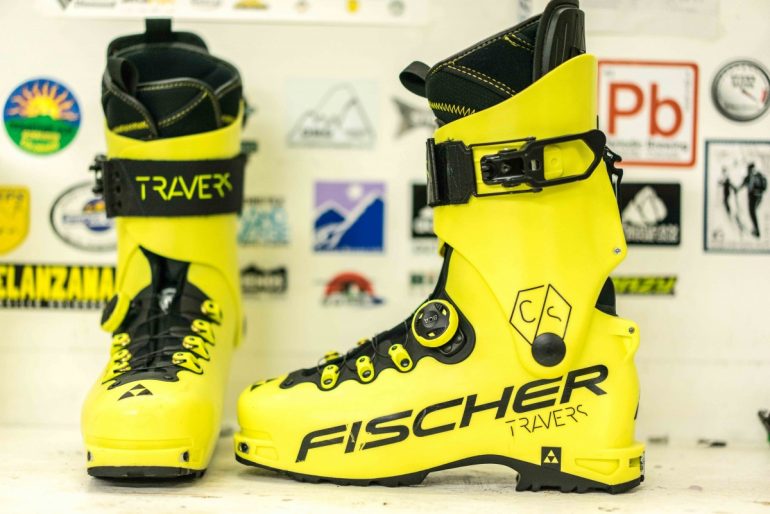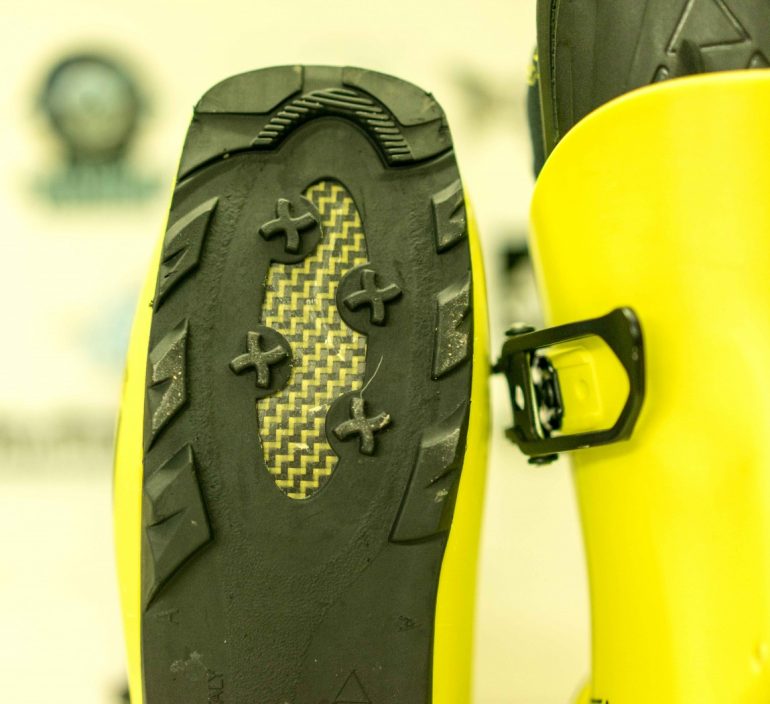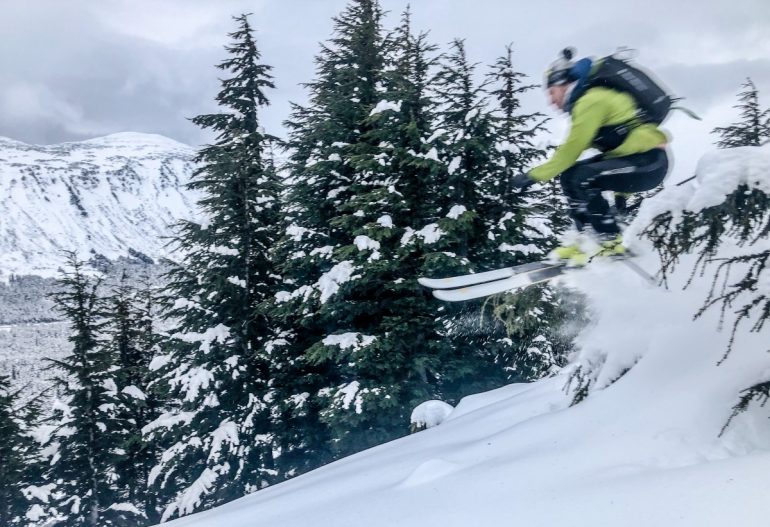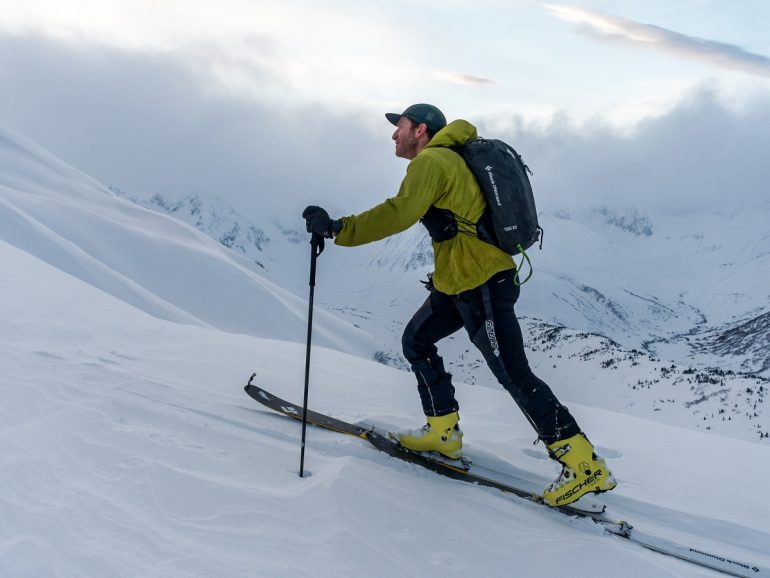
Now you’re going to want to coordinate your jacket if you really want the Travers CS to pop… Photo: Malcolm Herstand
One boot to rule them all, One boot to find them, One boot to bring them all, and in the darkness bind them…
I have long thought that having the right tool for the job requires a quiver of options. I have applied such logic broadly in life — acquiring a large collection of wrenches, always making sure to give both bourbon and scotch space on the shelf, opting for Neapolitan ice cream, and of course sporting a healthy range of ski widths. As far as boots go, I have rocked skimo style light-is-right boots as my everyday drivers for sometime, but have always kept some beef in the freezer too. The last couple of seasons, the La Sportiva Sytron has been my go to, with a pair of Salomon MTN Explores on the shelf for ‘big ski’ days. The Fischer Travers CS — a 1 kilo category, carbon-soled, touring machine — is making me rethink my logic.
Light as they may be, folks will find these to be a good boot for a lot of daily drivers. I’ve had a hoot in the Travers CS riding 88 underfoot skis. What has been so surprising is how they handle 114s in deep pow just fine, while also feeling chargtastic for hot laps in good snow on Peak 3 outside of Anchorage on 76s.
If I ever need to carry ski boots across Middle Earth and still have the power to charge down Mount Doom – Travers CS all the way:
-Grilamid Shell
-Carbon/Aramid plate in the sole
-Boa
-80 degrees range of motion
-104mm last (on 28.5)
-Mediumish flex
-~1150 grams (advertised at 980, more on this below)
The Basics
Fischer jumped into the touring boot game with the Travers Carbon, the Travers CS is the update. This boot is aimed at a touring crowd with weight in mind. The Travers CS is most comparable to the F1, TLT, or Backland. All have pretty good walkability, but the downhill performance on the Travers CS stands out to me because of the lean, flex, power transfer, and cuff design. Fischer has shown a strong entry into the kilo boot class, proving that if you know how to make killer boots, you can make killer boots lighter.
While light boots often feel like low-cut sneakers with an ankle brace attached, engaging them often feels like falling into a wall. Low cuffs that throw you in the backseat are sometimes the hurdle, other times it’s stiff tongues, still others it’s ski-walk buckles that leave you too tight on the up and too loose on the down. The Travers CS aims to solve these issues.
A relatively high cuff, large strap (they call it the ‘Phatt Maxx,’ so there’s that…) that locks open for tour-mode (and takes out quite a bit of slack when flipped for the downs), simple vertebra bar for ski-mode, and grilamid shell, all still manage to give a some progressive flex, good power transfer, and solid feel. A carbon plate in the sole has managed to lighten up a boot with incredible torsional stiffness [note: Fischer briefly offered a version with a carbon upper, the ‘Travers CC’, but recalled this version after some issues came to light]. The TLT and Backland may still be ‘stiffer’ than the Travers CS when maxed out, but the weight, forward lean, progessive-ish flex, and placement of the wide cuff strap more than make up for it, helping these fly on the up or down.
A spoiler that velcros onto the stock Palau liners (not the Lace liners listed on the website) helps give an extra bit of forward lean. I thought this was a gimmick when I pulled it out of the box. After skiing with it one, I will never take it off. Another potential gimmick advertised is Fischer’s ‘Somatec’ stance. Essentially the boot flares out a couple of degrees from parallel with your ski – supposedly for better power transfer. Although I can’t say I’ve noticed it much, my knees have been super happy in these boots, maybe the stance has something to do with it.
Fit
Like many skiers, I have hobbit feet. Flat feet and bunions have always made fit a challenge. While my feet might be unusual, the problem I have with boots that are ‘pointed’ in the toe is fairly common. I need a high volume forefoot, with a snug heel and midfoot which usually means spending a lot of time baking liners and punching shells. Contrary to all that, I have skied about 50,000 ft on the Travers CS without a blister straight, out of the box.
While the ski boot industry has finally realized that we all spend most of the day going uphill, too many boots still force a bargain between range of motion on extension and downhill performance – not the Travers. In part this is helped by the long way the Boa system seems to have come in the last few years. I feel like I can get the Boa on the Travers tight; it sinches evenly across the lower with the help of brass pulleys, and it hasn’t broken yet. Low volume feet won’t think it’s snug enough (low volume feet probably want to size down in the Travers), but it works for me–what else can I say.
Fischer advertises 80-degrees of motion, but what impresses me is not the range, but how usable the range is. Often boots advertise an ROM that includes ankle compression that isn’t part of a normal stride (in other words, motion that isn’t useful). The Travers CS walks as good as just about any boot north of 800 grams.
Liners
I really like the stock Palau liners. I know Intuition gets more fan fare, but Palau liners breathe well, mold great, give good padding and support where needed, and hold up. Oh yea, and they are plenty warm. I’ve seen folks out there online trash Palau liners with stories of cold feet; I took these up to the Alaska Range over New Years, it was -20F and my toes were just fine.
[***side note: If you want warm toes, don’t just up the liner. Think about layering well on your legs, keeping your core warm, wearing the right socks (not too tight in the boot), and staying hydrated and fueled. If after all that your toes are still cold, consider getting a pair of overboots for those frigid days. I’m personally a fan of the 40-below overboots with toes and heels cut out for bindings. If you want your boot to keep up with the coldest day without everything mentioned above, you will be sweating most of the year, and blistering all spring.]
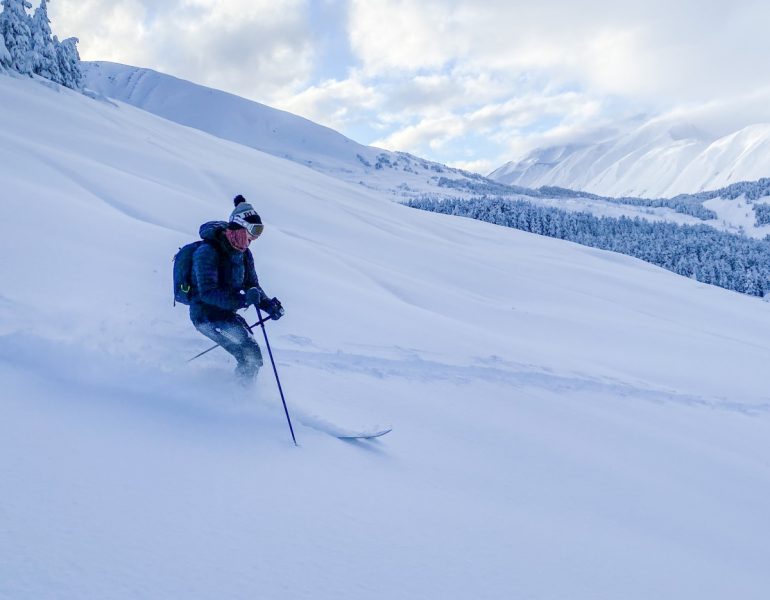
Taking the Travers CS out for some low angle hippy pow on a high avy danger day. Photo: Maresa Jensen
A couple of cons
-This sounds a bit odd, but these are more annoying to step into bindings then I’ve been used to the last few seasons, perhaps because of the shape of the toe?
-These boots should shine in variable snow on little skis, but it’s easy to ‘overdrive’ small sticks and get kicked into the backseat. I’ll happily share half the blame here, but I am surprised that while these perform beyond expectation on big boards, and fabulously in the middle of the road, I am less enthusiastic on small sticks (for me, that was on 76s).
-The tongue on the lower has to get pushed into the boot every time you cinch up the Boa – this is annoying, especially with gloves on.
-There is very little rubber on the sole (saves weight). It’s been snowy, but as soon as spring ski mountaineering season comes around, I worry it won’t hold up – we’ll see…
– “980g” is printed right there on the side of the boot, and they are quite light… but not nearly as light as advertised. The shell alone on the 28.5s comes in on my scales at 945g; the liner comes in at 155g; the stock footbeds come in at 20g. So these run 1120 grams at a minimum. If you add the spoiler (33g), the optional extra volume footbeds (18g) you’re up to 1170 grams (everything that comes in the box). I swapped out the stock bed for a decent custom footbed and am now over 1200 grams. Running between a third of a pound and half a pound more than advertised per boot is just too much. The Travers CS is still a wicked light boot solidly in the 1-kilo category, but Fischer should not be exaggerating the number down to 980.
In summary
Overall, the paired down simplicity and versatility of the Travers CS is refreshing. They are a good boot for a wide range of skis, skiers, and ski days.
I will be super happy taking these boots on every day ski tours, big traverses, hut trips, peak bagging missions, couloirs, and pow laps. I probably won’t huck my meat off a cliff or race the GT in them, but the Travers CS have a heck of a range. Also they are green! Or is it yellow? They’re like a neon yellow-green! Anyways, the eagles will be able to spot you from a mile away.
Two thumbs up.
SPECS
Weight: 1120g (confirmed for 28.5)
Flex: 90
Last Width: 100mm
Material: Grilamid
Forward Lean: 14 degrees w. spoiler
Cuff Articulation: 80
Sole: No Torsion, Carbon, Arimid
Buckles: Boa with Power Strap
Binding Compatibility: Tech
Shop for the Fischer Travers CS
Dr. Alex Lee lives in Anchorage, Alaska. Alex is a professor at Alaska Pacific University, teaching philosophy and environmental studies. He also works as a sometimes guide, naturalist, writer, and photographer.

